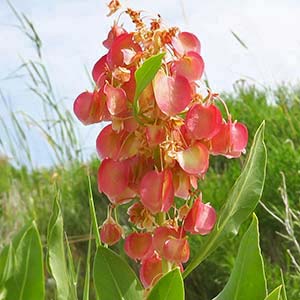Rumex venosus
Rumex crispus
rumex veine, vein dock, veiny dock, wild-begonia, wing dock
curled dock, curly dock, patience crépue, reguette, rumex crépu, sour dock, yellow dock
ascending or, rarely, erect, usually producing axillary shoots near base, (10–)15–30(–40) cm.
erect, branched distal to middle, 40–100(–150) cm.
blades ovate-elliptic, obovate-elliptic, or ovate-lanceolate, (2–)4–12(–15) × 1–5(–6) cm, subcoriaceous, base narrowly to broadly cuneate, margins entire, flat or slightly undulate, apex acute or acuminate.
ocrea deciduous, rarely partially persistent at maturity;
blade lanceolate to narrowly lanceolate or lanceolate-linear, normally 15–30(–35) × 2–6 cm, base cuneate, truncate, or weakly cordate, margins entire to subentire, strongly crisped and undulate, apex acute.
terminal and axillary, usually occupying distal 2/3 of stem/shoot, usually dense, or interrupted in proximal part, broadly paniculate.
terminal, occupying distal 1/2 of stem, dense or interrupted at base, narrowly to broadly paniculate, branches usually straight or arcuate.
articulated near middle, filiform or slightly thickened, (8–)10–16 mm, articulation distinct, slightly swollen.
articulated in proximal 1/3, filiform, (3–)4–8 mm, articulation distinctly swollen.
5–15 in whorls;
inner tepals distinctly double-reticulately veined, orbiculate or reniform-orbiculate, 13–18(–20) × (20–)23–30 mm, base deeply emarginate or cordate, margins entire, apex rounded, obtuse, rarely subacute, with short, broadly triangular tip;
tubercles absent, occasionally very small.
10–25 in whorls;
inner tepals orbiculate-ovate or ovate-deltoid, 3.5–6 × 3–5 mm, base truncate or subcordate, margins entire or subentire to very weakly erose, flat, apex obtuse or subacute;
tubercles normally 3, rarely 1 or 2, unequal, at least 1 distinctly larger, more than (1–)1.5 mm wide.
brown or dark brown, 5–7 × 4–6 mm.
usually reddish brown, 2–3 × 1.5–2 mm.
= 40.
= 60.
Rumex venosus
Rumex crispus
Rumex venosus is a distinctive species rarely confused with any other members of the genus. However, I have seen herbarium specimens of it misidentified as R. hymenosepalus, and vice versa.
(Discussion copyrighted by Flora of North America; reprinted with permission.)
Rumex crispus (belonging to subsect. Crispi Rechinger f.; see K. H. Rechinger 1937) is the most widespread and ecologically successful species of the genus, occuring almost worldwide as a completely naturalized and sometimes invasive alien. It has not been reported from Greenland, but it probably occurs there.
Rumex crispus hybridizes with many other species of subg. Rumex. Hybrids with R. obtusifolius (Rumex ×pratensis Mertens & Koch) are the most common in the genus, at least in Europe, and have been reported for several localities in North America. Rumex crispus × R. patientia (Rumex ×confusus Simonkai) was reported from New York. According to R. S. Mitchell (1986, p. 47), “this hybrid is now spreading along highway shoulders, and it has replaced R. crispus in some local areas.” However, that information should be confirmed by more detailed studies since spontaneous hybrids between species of sect. Rumex usually are much less fertile and ecologically successful than the parental species. Hybrids of Rumex occuring in North America need careful revision.
Numerous infraspecific taxa and even segregate species have been described in the Rumex crispus aggregate. Many seem to represent minor variation of little or no taxonomic significance, but some are geographically delimited entities that may deserve recognition as subspecies or varieties. The typical variety has inner tepals with three well-developed tubercles; the less common var. unicallosus Petermann, with one tubercle, occurs sporadically in North America.
Some eastern Asian plants differ from typical Rumex crispus is having somewhat smaller inner tepals, longer pedicels, lax inflorescences with remote whorls, and narrower leaves that are almost flat or indistinctly undulate at the margins. These plants, originally described as R. fauriei Rechinger f., are now treated as R. crispus subsp. fauriei (Rechinger f.) Mosyakin & W. L. Wagner; the subspecies was recently reported from Hawaii (S. L. Mosyakin and W. L. Wagner 1998) and may be expected as introduced in western North America.
(Discussion copyrighted by Flora of North America; reprinted with permission.)
- Local floras:
CA,
OR,
WA
- Local Web sites:
CalFlora,
CalPhotos,
Flora NW,
KS Wildflowers,
MN Wildflowers,
PNW Herbaria,
Turner Photog.
WildflowerSearch
iNaturalist (observations)
USDA Plants Database
- LBJ Wildflower Center
- SEINet
- Plants of the World Online
- Encyclopedia of Life
- Wikipedia
- Google Image Search
- Local floras:
BC,
CA,
OR,
WA
- Local Web sites:
CalFlora,
CalPhotos,
Flora NW,
Go Botany,
IL Wildflowers,
KS Wildflowers,
LA Plants,
MD Biodiversity,
MI Flora,
MN Wildflowers,
MO Plants,
PNW Herbaria,
SW CO Wildflowers,
Turner Photog.
WildflowerSearch
iNaturalist (observations)
USDA Plants Database
- LBJ Wildflower Center
- SEINet
- Plants of the World Online
- Encyclopedia of Life
- Wikipedia
- Google Image Search


